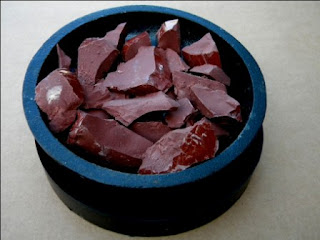I should mention that this was not my first attempt at setting up the pitch. However, the first time, I had black pitch. I read that the black pitch was really not the way to go because the red variety was much more pliable, but the black pitch was SO much cheaper. It came in some sort of tin can and was extremely brittle. The pieces that I got into the pitch bowl resembled jagged, broken glass. When I heated it to put a piece of metal into it, the metal wouldn’t really sink into it and would often break—almost snap, really—away from the pitch when I checked to see if it was secure. So I put it aside and eventually ordered the red pitch. What a difference! I chiseled pieces of the pitch away from the block form easily; the pieces were sort of soft and dense. (I’m not sure why it comes in a giant block…I only put about one sixth of it into my pitch bowl.)
The pitch melted easily and smoothly.
I used a piece of copper and drew circles on it with my template. Then I went over the lines with a scribe to give my chasing tools a guide to follow.
The basic process goes something like this: heat the pitch to soften it and place the metal on it. Then chase on one side of the piece, outlining the design. Heat the pitch again to loosen the metal, flip it over, and work the metal on the opposite side to give it depth. Repeat, repeat, repeat. Well, most people probably wouldn’t repeat as much as I did—I was experimenting with moving the lines a bit and just getting the feel in general, so I know that I overworked the metal. In fact, I was surprised that I didn’t ever actually go through it.
The chasing tools and hammer I used:
Here is the piece, early in the process and at the end, prior to cleaning.
And as final as this will get--I didn't want to spend much time trying to clean it up since it is just a tester.
Some notes for future attempts:
1. Sometimes being a cheapskate can make things harder. I should have just bought the red pitch to begin with. (Ok, I didn't actually learn that lesson just now, and I probably won't follow it in the future. The force is too strong in me.)
2. There is NO NEED to push the entire piece all the way down in the pitch. It makes a mess to clean off when flipping the piece and I found that pushing just the corners in worked well.
3. I need to do a bit of research on how to really clean a piece like this. I didn't put it in the pickle pot because I didn't want to get any pitch in there, but I'm not sure what the proper procedure is. Not a big deal on a test piece, but it will matter later.
I have a lot of practice time in front of me if I am going to make anything using this technique, but I like the challenge, so maybe I will have more of this to post down the line.







This. Is. Amazing. My jaw, dropped. Wow.
ReplyDelete